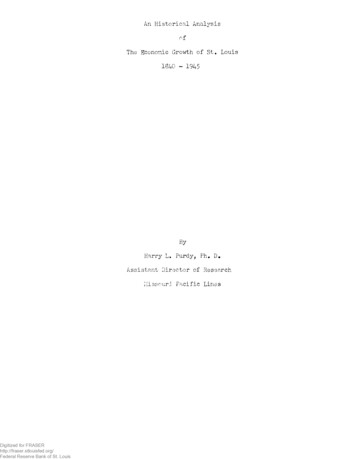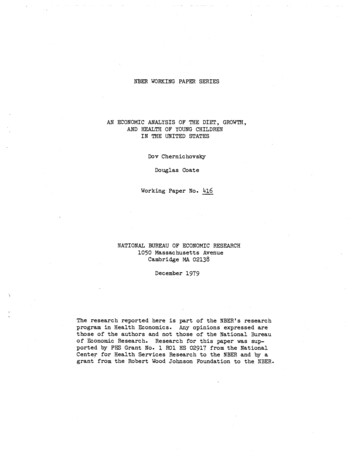
Transcription
Digitized for FRASERhttp://fraser.stlouisfed.org/Federal Reserve Bank of St. LouisAn Historical AnaljrsisofThe Economic Growth of St. Louis1840 - 1945ByHarry L. Purdy, Ph. D»Assistant Director of ResearchMissouri Pacific Lines
IndexPart IThe River Metropolis, l8k) l870PageLocation Factors and Their Influence on St. Louis1Regional Specialization and Regional Interdependence. . . . . .9The City From l8k0 to l8?0."13The City and The Steamboat20Commerce and Industry.26The Influence of Railroad DevelopmentEffects of the Civil War51Part IICommercial and Industrial Development 1870-1910Gro\rth of the City and Its PopulationRail and River, 1870-191057Commerce and Industry, 1870-1910. . .62Rise and Decline of Iron Production .80Value of Manufactures, 1870-191086Part IIICommerce and Industry 1910-19 -5General Business ConditionsPopulation Trends93. . .Commercial Trends 1910-19 -098The St. Louis Trade AreaManufacturing 1910-19 5Digitized for FRASERhttp://fraser.stlouisfed.org/Federal Reserve Bank of St. Louis97107, .112
iiAppendices . . . . . . .Page124 ff.AppendixValue of ManufacturesSt. Louis, 1870 and 1875BReceipts and Shipments of Grain - St. Louis. Mo., 1867-1923CReceipts of Leading Commodities at St. Louis, Mo., 1859-1883DReceipts of Leading Commodities at St. Louis, Mo., 1865ESt. Louis Receipts By River and Rail, 1873FSt. Louis Shipments By River and Rail, IS65GSt. Louis Shipments By River and Rail, 1873EReceipts and Shipments of Cattle, Sheep, Hogs, Horses andMules - St. Louis, 1867-1923.IValue of Manufactures, in Leading Industries St. Louis Citya,nd St. Louis Industrial Area For Selected YearsJCotton Compressed at St. Louis, 1875-1923KPopulation of St. Louis and Chicago Industrial Districts," 1840-1940LRailroads, i860, 1870, i860, I89OMGross and Net Receipts of Cotton at St. Louis, 1871-1923NReceipts, Manufactures and Shipments of Flour - St. Louis, Mo.,I85I-I9230Receipts and Shipments of Bran and Mill Feed - St. Louis,1867-1923PReceipts and Shipments of Hay, St. Louis, 1867-1923QShipments of Bulk Grain "by River From St. Louis toNew Orleans, 1874-1893RReceipts and Shipments of Wool, St. Louis, 1867-1913SSt. Louis Receipts and Shipments of Lead, I867-I923TTobacco Manufactured First Missouri Internal Revenue CollectionDistrict 1873-1913Digitized for FRASERhttp://fraser.stlouisfed.org/Federal Reserve Bank of St. Louis
iiiAppendicesAppendixUReceipts and Shipments of Hog Products - St. Louis1867-1913VHogs Packed in the West and at St. Louis and East St. Louis,1878-1912 Total Value of Manufactures By Decades 1880-19 0 For TheSt. Louis Industrial Area With a Breakdown "by ComponentAreasXWheat. Corn, and Oats—Receipts at Primary Markets, By CropYears: 1933 to 19 3YBuilding Permits Issued - St. Louis, 1875-1913ZTrend of Receipts and Shipments "by Rail and River, St. Louis,1883-.1923AA.Business of St. Louis Bridges and Ferries, 1883-1923BBReference BibliographyDigitized for FRASERhttp://fraser.stlouisfed.org/Federal Reserve Bank of St. Louis
PART IThe River Metropolis, 18UO-I87OLocation Factors and Their Influence on St. LouisAn exclusive right to the Missouri River Indian trade probablyaccounts more than any other factor for the precise location of St. Louis.The Louisiana Fur Company, known also as Maxent, Laclede and Company, needed a trading post near the mouth of the Missouri River and Laclede in 1763found on the eastern edge of present day Saint Louis a site with the desired characteristics. First, of course, it was at the front door of theMissouri territory. In addition boats could be brought directly in for alanding and yet higher ground rising back from the river gave level areasneeded for the proposed village and also promised protection against riverfloods. While the importance of its original advantages has long sincedisappeared the location possessed features which were ofinterest toLaclede, but which, in the economic environment of the Nineteenth Century,helped materially in the making of a great city.The twenty years preceding the Civil War have long been recognized as the heyday of the steamboat. In this period St. Louis was at thestrategic center of one of the two great inland water transportationsystems of the continent. In a letter, dated June 20, I8V7, to the St.Louis delegation to the Chicago Convention, the Honorable Thomas H. Bentondescribed this central position with considerable enthusiasm."Many years ago the late Governor Clark and myself undertook to calculate the extent of boatable water in the valleyof the Mississippi; we made it about fifty thousand miles.' ofwhich thirty thousand were computed to unite above St. Louis,and twenty thousand below. Of course, we counted aJll theinfant streams on which a flat, a keel, or a bateau could befloated, and justly for every tributary of the humblest boatable character helps to swell not only the volume of thecentral waters, but the commerce upon them. Of this immenseextent of river navigation, all combined in one system ofwaters, St. Louis is the centre and the entrepot, presentingeven now, in its infancy, an astonishing and almost incredibleamount of commerce, destined to increase forever.11 "Quoted in Scharf, J. Thomas, History of Saint Louis City and County(1883), Vol. II, p. 1037.Digitized for FRASERhttp://fraser.stlouisfed.org/Federal Reserve Bank of St. Louis
2As a site for the major harbor on the great inland vatewaysystem, so rapturously described by the tla S. Senator from Missouri, St.Louie left a great deal to be desired. It did possess one advantage ofparamount importance to towns located on the shifting Mississippi - arocky foundation. It was thereby protected from the fate that befell itsneighboring predecessor, Ste. Genevieve, Thirty years before the timewhen Laclede passed on his way up the river, the first white settlement inMissouri had been established by lead miners and hunters near the presentsite of Ste. Genevieve. However, even while the Louisiana Fur Company wasdeveloping its trade in the Upper Mississippi area the Mississippi wasforcing inhabitants of the village to move back as banks of the river wereeroded. By 1790 the original site was wholly abandoned. In 1850 when St.Louis could claim 104,978 residents, Ste. Genevieve had a population ofonly 2,258 and this represented the peak to which its population was togrow. Changes occurring in the channel of the river since that date haveleft the town some three miles west of the river. Other towns have beencrippled by floods and by the vagaries of the changing Missississippi *channel. St. Louis, however, while finding far from ideal conditions onthe banks of the riverA was at least well protected against annihilationfrom erosion or flood.d One study of the advantages and disadvantages ofthe St. Louis port, relative to others available in the area, comments thatat least "it was obvious that it would be far more likely to bepermanent. "3 The permanency of the St. Louis site may have been obviousto Pierre Laclede but it is more likely that being in possession of aneight year monopoly grant for the Missouri fur trade he was much more concerned with other aspects of the site,A comment made in 185 by the commercial chroniclers Chambers andKhapp suggests that Laclede in choosing the precise site for his tradingpoet might have been interested in little more than the presence of aclearing!The next year (1763) Laclede set out to explore thecountry assigned to him, accompanied by two youths, afterwardswell known citizens of this place, the brothers Auguste andPierre Chouteau. Having carefully examined every point on theriver, not omitting Ste. Genevieve, which had then for tenyears been the headquarters of a considerable trade in peltryand lead, he satisfied himself that no other site presentedthe advantages sought for him to so great an extent as thespot on which now stands St. Louis. It was, at the time whenLaclede first set foot upon it, a beautiful expanse of undulating prairie, free from woods, save at one point on theriver bank, near the centre of the present city, which wasthen embellished by a grove of noble forest trees.11f,-Violette, Eugene Morrow, A History of Missouri (1918), pp. 12-13,cf., Williams, Helen D., Factors in the Growth of St. Louis FromiQkO to i860 (193*0, PP. 2-3. Marshall, Willis W., Geography of the Early Port of St. Louis (1932),P. 31.2Digitized for FRASERhttp://fraser.stlouisfed.org/Federal Reserve Bank of St. Louis
3The terraces or "bluffs comprising the waterfront of St. Louieoffered protection against floods but were no inconsiderable nuisance tothe busy port city of the steamboat era. Warehouses must be crowdod downalong the levee or built back at 'inconvenient distances and separated bysteep slopes from the narrow strip of flat shoreline. Apparently crowdingwas preferred, for after the fire of UB49 serious proposals were made thatthe city should buy the property between the levee and Commercial Streetbetween Vine and Market arad leave it open as a part of the levee.1 Nothingcame of the matter. Crowding and disorder on the levee continued to make acostly problem for the steamboat operator and the merchant. A visitor tothe city in 1850 admired the warehouses but found no pleasure in their location "Water Street is well built up with a series of loftylimestone warehouses; but an irretrievable error has beencommitted in arranging them at so short distance from thewater. On some accounts this proximity to the river may beconvenient; but for the sake of a broad area for commerce;for the sake of a fresh and salubrious circulation of airfrom the water; for the sake of scenic beauty, or a noblepromenade for pleasure, there should have been no encroachment upon the precincts of the feternal river1." The steamboatmen and merchants probably worried very little aboutthe loss of "fresh and salubrious circulation of air" but they no doubtfound their own way to express their exasperated displeasure at delays andloss of merchandise occurring on the levee.5An even more troublesome fault that threatened the very existenceof the port developed in the early steamboat period. Such heavy siltingoccurred that the "waterfront" was threatening to move inland. Normally ariver port would find a favorable location on the outside of a meander. Inthat position it would have its waterfront scoured by the current of theriver and would enjoy deep water and an absence of silting. On thestretches of the river in which Laclede was interested the eastern bank wassubject to flooding and no doubt in his canoes and pirogues Laclede waslittle concerned with shallows that might develop some time in the futurefrom silting. So the St. Louis site suited his purposes but presented itsproblems to a port city a few decades later. The predicament in which thecity found itself is described by Scharf as follows:"Almost coincidently with the arrival of the first steamboat at St. Louis in iSlT a sand-bar formed in the bend at thelower end of the town, which gradually extended up as far asMarket Street, making a naked beach at low water. Another barsoon formed in the river at the upper end of the city, west ofBloody Island. Thus, at the very outset of the commercialprogress of St. Louis, the current of the Mississippi, cutting Marshall, Willis W., Geography of the Early Port yf St. Louis (1932),PP. 31-38.2cf., Stevens, Walter B., History of Saint Louis, the Fourth City,1764-1909 (1909), PP. 535-6.3cf., Marshall, Willis W., Geography of the Early Port of St. Louis(1932), p. 38. 'Digitized for FRASERhttp://fraser.stlouisfed.org/Federal Reserve Bank of St. Louis
ifdeeper and deeper into the American Bottom on the eastern sideof Bloody Island, was threatening the city with the diversion ofits channel to the east side of the island, leaving St. Louis'high and dry1, with a sand-bar in front of it.In this crisis it was generally predicted that the citywould amount to nothing in a commercial point of view, andthe timid refused to make investments in real estate, fearingthat the town would be left without the facility of availingitself of the benefits which the new steam system of navigation promised."* Efforts made in 1835 to remove sand-bars from the harbor by plowing were fruitless and the city turned to Congress for aid. The firstFederal work on the harbor was undertaken in 1837 under the direction ofLieut. Robert E. Lee. The problem continued all through the years untilthe decline of steamboating, but intermittent aid from Congress and thepersistent efforts of city officials prevented closing of the harbor thatmight have placed the city beyond resuscitation by the later-arrivingrailroads.Two other hazards militated against the growth of St, Louis asthe entrepot of the Mississippi Valley. The first was damage to vesselsfrom ice. In some winters the port could be used, and was used, for wintering steamboats. But a severe winter in 1856 brought staggering lossesto the port in the break up of ice in late February.Ten steamboats weresunk and many others were badly damaged as ice to the thickness of fourfeet moved down in mass on the port. Two Alton wharf-boats which had probably been wintered at St. Louis for safety were shattered to pieces andcast up on the shore on a ridge of ice.5Although the losses were particularly heavy in 1856, damageoccurred in many other years and the danger was an ever-present one hurtingthe development of the city. " In his study, The Declining Significance ofthe Mississippi as a Commercial Highway, John B. Appleton characterizedthe port as "a veritable killing place for steamboats from ice movements"?A second hazard affected St. Louis through a danger present to aspecial degree on the river stretches immediately above and below the port,Floods on the rivers above St. Louis, particularly on the Missouri, broughthuge trees and masses of debris down the river. Lodging in the channelsbelow St. Louis they created a viciously destructive obstacle to navigation.IScharf, J. Thomas, History of Saint Louis City (l88j), Vol. II,p. 1053. Marshall, Willis W # , Geography of the Early Fort of St. Louis (1932),P. 73. Chittendon, H.M., History of Early Steamboat Navigation on theMissouri River (1903), p. 207.**cf. Reinhardt, A a H., Gunboats of James B. Eads During the Civil War(1936), p. 19.5Appleton, John B„, The Declining Significance of the Mississippi as aCommercial Highway in the Middle of the Nineteenth Century, Reprinted inR. G. Thwaites, Early Western Travels.Digitized for FRASERhttp://fraser.stlouisfed.org/Federal Reserve Bank of St. Louis
5There is a record of insurance companies in Cincinnati paying out 234,000to cover steamboat losses occurring in the 180 mile stretch from St, Louisto the Ohio in the short period of 6 weeks in the Fall of 1842.1 Firesand explosions contributed their part to these losses but snags andshallows made up the major risks.In this same short stretch of river 72steamboats were sunk in 17 months during the years 1842-3. Snagboats atwork on the river in the 1830*s did a great deal to reduce the hazards butthe disadvantages found on the river below St. Louis remained large:"As early as 1841 the attention of Congress was called tothe condition of the Mississippi above the mouth of the Ohio.From 1836 to l84l it was said that more property had beendestroyed from the mouth of the Ohio to St. Louis by snags thanon all the other parts of the river and its tributaries. Notwithstanding the general government had provided snag-boats forthe lower river, the manifest neglect of the Western riverswas entailing an annual loss of millions of dollars upon thecommerce of the West, owing to the dangerous and destructivecondition of the then only commercial highway for that greatsection of the country.'' The average steamboat did not last more than five years. Afterthat they were obsolescent or had sunk or been blown up. Around 1850 onone bend in the, river between St. Ltfuis and Cairo there lay the wrecks of103 steamboats.4With all the disadvantages militating against the developmentof St. Louis in the heyday of steamboating it may well be asked why theredeveloped on the site of Laclede's old settlement the entrepot of theMississippi Valley. The raw material wealth of the upper valley and theregional economic specialization developing in the United States made itinevitable that a great commercial city would develop somewhere on thelower Ohio or on the Mississippi between Memphis and some more northerlypoint on the river. But why at St. Louis?Among the historians who have depicted and analyzed the growthof Saint Louis there is complete unanimity of opinion as to the reasonsfor the development of the particular site on which Lac lode?s village of10,000 population stood in l8l at the beginning of steamboating on theMississippi River System. These views are rather completely summarizedin the following excerpt from L. Y. Hortonls Analysis of the St. LouisTrade Area: ' Hall, J., The West (l848), pp. 60-6l.Allen, T., Commerce and Navigation of The Valley of TheMississippi (l848), p. 11 ff'.2 Scharf, J. Thomas, History of Saint Louis City (1883), Vol. II,p. 1043. Stevens, Walter B*, St. Louis The Fourth City, 1764-1909 (1909)P. 357.Digitized for FRASERhttp://fraser.stlouisfed.org/Federal Reserve Bank of St. Louis
6"It is common knowledge that wealth and population(therefore, cities) tend to concentrate about breaks intransportation, whether the breaks be between land andwater transportation, between two types of land transportation, or between two types of water transportation.In this regard, St. Louis was doubly fortunate becausethere were both breaks between two types of water transportation and between land and water transportation.The channel of the Mississippi below St. Louis hada minimum depth of about six feet, while above St# Louisthe minimum depth was only three or four feet. With thedevelopment of larger river steamers, the effect of thesedifferences in the depth of the channel in these twointegral parts of the river was the breaking up of theriver traffic into two fleets, one adapted to the deeperwaters south of the city and the other to the shallowwaters north of the city. The reason for this was thatit was cheaper to carry on business in the larger vesselswherever possible and to use the smaller vessels only wherethe larger ones could not operate because of the shallowness of the water or the inconsiderableness of the cargoesavailable. Although it was possible during the spring andfall of the year for vessels with a deeper draft to penetrate farther northward than St. Louis, it became thegeneral practice to limit their use to the lowerMississippi.As a result, St. Louis became the bulk breaking andreshipment point, as it was at this city that the cargoeswere unloaded from the deep draft vessels and reloaded onthe shallow, and vice versa. In this way St. Louis becameestablished as a transfer point and it was both the northernterminus for one great fleet of steamboats and the southernterminus for another. Another reason for the early growthof the commercial aspect of the city was its position. Itwas located at the crossroads of the oast-west and thenorth-south traffic. This situation was enhanced by thefact that it was the crossing of the east-west overlandtraffic and the north-south river traffic."-**Norton, L. Y., Analysis of the St. Louis Trade Territory (1935),pp. 13-lU.Digitized for FRASERhttp://fraser.stlouisfed.org/Federal Reserve Bank of St. Louis
7It seems that a "handicap" in the dominant river transportationendowed the St. Louis site with its essential advantage as a commercialcenter.1 In addition to change in depth of the river channel at St. Louisand the "break created by the river in overland east-west transportation,another related factor also enhanced the commercial value of the St. Louislocation. New Orleans and other lower Mississippi points and variouseastern points, such as Baltimore and Pittsburgh, shipped freight by theMississippi or the Ohio to various destinations on the upper Mississippiand on the Missouri Biver. As a result a break-up of bulk shipments at somedistributing point was almost inevitable. With the change in ruling riverdepth at St. Louis the city was the obvious reshipment point. Finally,even the weather offered some strengthening of these factors which placedhigh value on the site of Saint Louis as a commercial center:there was a seasonal difference in the period during"which goods were available for transportation above and belowSt. Louis. The reasons for this were two-fold; the stage of theriver differed above and below this port so that the river mightbe navigable below and yet not so above; usually in the springthe river below St. Louis would be open before that portion ofthe river above the port was free from ice. As a result ofthese two features of navigation, goods were brought up to St.Louis and stored until such time as the upper parts of theriver could be open to navigation. In view of the fact that itwas the commercial practice to reship the goods at St .Louis,it was necessary to hold the goods in store here until the upriver boats came downstream with the winter1s produce from theup-river regions. Likewise in the fall, the upper river wasclosed to navigation at a much earlier period than was the lower. Also see Williams, Helen D., Factors in the Growth of St. LouisFrom 1840 to i860 (193*0, p. 23:"That the city realized the importance of its position is clearlyshown by the following statement in the St. Louis BusinessDirectory for 18*1-2, page b2:1Owing to the depth of the water in the Mississippifrom the mouth of the Missouri down to New Orleansbeing much greater than in the waters above, the sameclass of boats which can be profitably employed inthe lower trade cannot ordinarily extend their tripbeyond St. Louis. . The result of this is to makeSt. Louis the great shipping point for the imports ofall the vast territories lying north and east of her,and a considerable portion of the trade south and east.1The carrying trade of St. Louis profited greatly from this situation. The city became the commercial mart for all the country fromthe mouth of the Ohio, north, and from Lake Michigan, west. Forthe first ten years of the period of this study every pound ofwestern produce and western merchandise broke bulk at St. Louis."Digitized for FRASERhttp://fraser.stlouisfed.org/Federal Reserve Bank of St. Louis
8As a result of these factors, the ease of obtaining a cargowas characterized by a high degree of seasonality, the twoperiods of excessive activity being in the spring and fallof the year.Had there been no suoh difference in the periods ofopen navigation on the river, and had this break in navigation been at some other point, it is possible that St. Louiswould not have achieved the significant place that it did asa base of supplies for the up-river regions or as a placefor storage of freights.fflIn respect to east-west land travel the river offered a "break11in transportation that was to be of much greater importance in the periodafter 1865 when a variety of railroad routes centered in St. Louis. Inthis earlier period and until the Eads Bridge was completed in 187 St.Louis was served by steam-powered ferries. The first charter for thisservice had been granted in 1819 to Samuel Wiggins who sold his boats andfranchise in 1832. Other ferry companies were enfranchised but a virtualmonopoly was held by the original Wiggins Company. Although the servicesand the charges of the ferry company seemed to be as satisfactory as conditions permitted, ferrying across the Mississippi with interruptions bystorm and ice never supplied adequate means of communication between theeast and west banks of the river.The flow of east-west commerce was checked by the obstacle presented by the Mississippi and an enhanced trade was deposited on the doorway of St. Louis just as a check in the flow of the river built up muchless desirable results in the form of sand bars in the river channel.However, St. Louisans did suffer from the uncertainty and high cost attaching to ferrying and early proposals were made for building a highwaybridge across the river.But the estimated cost of 737*600 was too muchto permit any progress to be made. The matter continued to be agitatedand a bridge company was formed in 1855 but financial support could not befound for it. In 1865 both a Missouri and an Illinois Company were chartered and by I87U the bridge was built under the guiding hand of James B.Eads. Marshall, Willis W., Geography of the Early Port of St.Louis (1932), pp. 9-30.Digitized for FRASERhttp://fraser.stlouisfed.org/Federal Reserve Bank of St. Louis2HOW, L., James B. Eads (1900), p. 57.
9Regional Specialization and Regional InterdependenceSituated in the West at a dominating "break" in one of the twogreat waterways of the continent, St. Louis was inevitably affected by theregional economic specialization and resultant interregional trade whichdeveloped with the rise of the "factory system".By iQkO the industrial revolution had given England her welldeveloped factory system. With the disappearance of domestic or home production, England lost the large measure of self-sufficiency she had formerly possessed as she came to specialize in factory production of manufactured articles. For food and raw materials she increasingly went abroad selling her manufactures in every settled portion of the world. Arelated development was evolving the same system of production in theUnited States, mainly in the northeastern portion. In America, as inEngland, the industries in which home manufacture first yielded to factorymethods were the textiles, particularly cotton. The concentration of manufacturers in eight eastern states is readily seen in the following figuresshowing the volume of manufactured cotton goods, woolens, and machinery inthe leading states and in the United States as a whole:1MassachusettsRhode IslandPennsylvaniaNew HampshireNew YorkConnecticutNew JerseyMarylandTotal - 9 statesTotal - U. S.Cotton GoodsWoolen Goods 5,9642, .086, io41,150,58042,688,1H146,350,453 446,'7io235,90017,7 3,17520,696,99?Machinery 050348,1657,787,45310,980,581Massachusetts with several areas well endowed with water powerhad shifted the center of the textile industry from Rhode Island to theMerrimack Valley which had become an important center of manufacture. Theproduction in Massachusetts of 2k million dollars of textiles and machinerywas equal to about thirty percent of the nationTs total output of theseproducts. The above figures show that between seventy and ninety percentof these leading factory products were manufactured in the New EnglandStates and Pennsylvania and New York. Other lines of production weregrouped around these leading industries to odd to the concentration of industry in the Northeast.By modern standards, the factories were small. The averagecotton mill had only 58 employes. Woolen mills, in many areas makinglittle headway against household manufacture, were still smaller with anaverage of 15 employes. However, these industries and many which had onlybegun to feel the impact of new production techniques were being pressed%ogart, E« L. and Thompson, C. M., Readings in the EconomicHistory of the United States (1929), p. 283.Digitized for FRASERhttp://fraser.stlouisfed.org/Federal Reserve Bank of St. Louis
10with varying speed into the new pattern. As transportation became morecertain and transportation costs fell precipitously with the development ofriver, canal, and railroad facilities, the practical market area of thefactory was tremendously widened. As a result, increased production fromindividual plants and from specialized areas became not only feasible butadvantageous as the factory organization with a larger scale of productionmaterially reduced manufacturing costs.In the decade before 1840, the pressures of new technical methodsand wider markets were exercising a growing influence on the organizationof lumber manufacture, flour milling, slaughtering, iron production, andmany others. Slaughtering was well on its way into the use of larger production units and Cincinnati was developing as the leading pork packingcenter of the country. By 1840, technical changes in the iron industrywere permitting the use of anthracite for smelting and a shift westward inthe center of that industry was foreshadowed. Small furnaces using charcoal for smelting had earlier set the iron industry in a long belt stretching from Lake Champlain to the Carolinas but signs pointing to the concentration of the industry in Pennsylvania were apparent. Further, theEnglish practice of smelting with coke from bituminous coal was making someheadway and was holding out promising opportunities to the bituminous coalregions of the country.A definite pattern of interregional trade, with important effectsfor St. Louis, developed out of the concentration of manufacture in theNortheast, the occupation of the South with its cotton kingdom, and theagricultural and frontier activities of the western states. From the East,a variety of manufactured products moved south and west; from the West,foodstuffs went to the other two regions either for domestic consumption orexport; and the South balanced its books, although they did not alwaysbalance, by its sales of cotton, hemp, sugar, and tobacco, mainly to theNortheast and to European markets.The regional specialization which was to center manufacturing inthe eastern states for decades was still only in its formative stages. Inthe decade from 1840 to 1850, Pennsylvania, Ohio and New York stood in thatorder in the national production of wheat. However, it is worth notingthat by i860 the three leading states were Illinois, Indiana and Wisconsinwith Illinois leading
U Receipts and Shipments of Hog Products - St. Louis 1867-1913 V Hogs Packed in the West and at St. Louis and East St. Louis, 1878-1912 Total Value of Manufactures By Decades 1880-19 0 For The St. Louis Industrial Area With a Breakdown "by Component Areas X Wheats at Primar.y Markets Corn, By Cro, anp d Oats—Receipt Years: 1933 to 19 3











